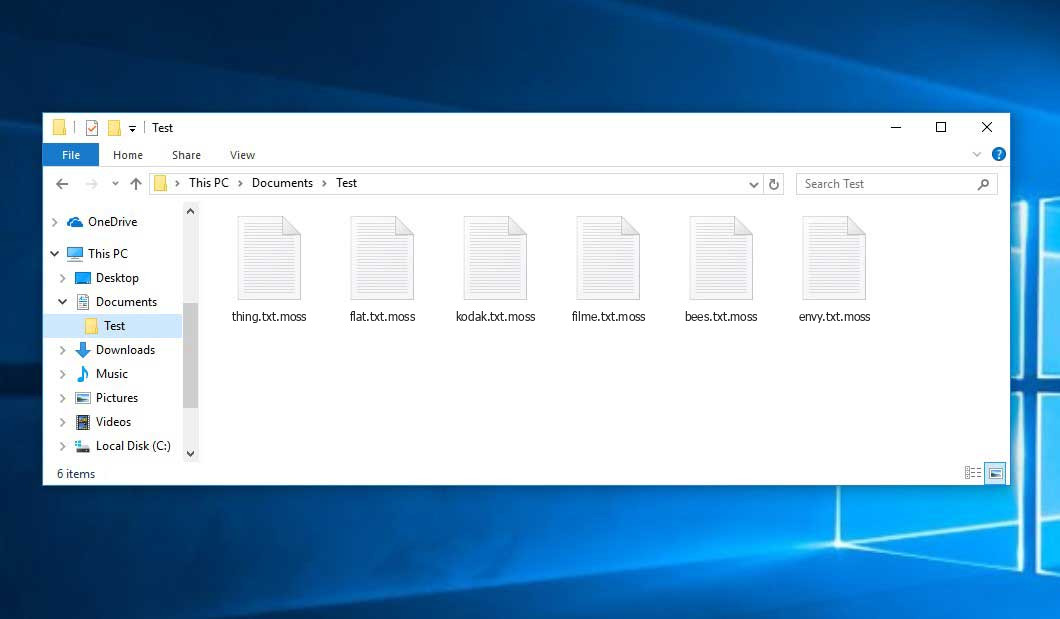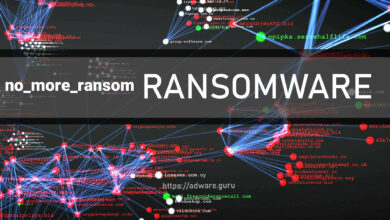Moss Virus Removal Guide (+Decrypt .moss files)
Moss – Ransomware
Moss is a malicious software working as common ransomware. Michael Gillespie, the well-known virus researcher, first found this new name in the DJVU ransomware family.
Moss was developed for the sole purpose to encrypt all popular file types. Logically, as soon as the encryption is successfully accomplished, the users are unable to get access to them. Moss virus includes its own “.moss” to all the encrypted files. For instance, the file “price_list.xls”, as soon as crypted by Moss, will be titled as “price_list.xls.moss”. Once the encryption is achieved, Moss puts its own distinct text file (_readme.txt) into all the folders that save the encrypted files.
The message specified by text file asking for the random os extremely comparable to the alerts given by other ransomware dangers coming from the DJVU family. The warning essentially indicates that the data has been secured and the only service to get access to it is to use an unique standalone key. Regretfully, this statement is definitely real.
The approach to secure the files utilized by Moss is not totally looked into. Nevertheless, there is no doubt that each computer owner may be released an unique decryption key, which is definitely special. It is extremely difficult to recover the data without the proper key in location.
“Don’t worry, you can return all your files!”, from text file message:
One more peculiarity of the Moss virus is that the users are not able to get access to the key. The decrypting key is hosted on an unique server under the total control by the scoundrels who have actually released the Moss ransomware into the web. In order to get the key and bring back the important information, the users are informed to connect with the frauds through e-mail or by telegram and to pay the ransom in the quantity of $980.
The message also says that individuals must call the Moss authors within 72 hours upon the moment of the information file encryption. The alert indicates that by doing so the people will obtain a 50% discount, for that reason, the ransom quantity falls to $490.
Moss crypted your files, however, it might not be the only risk on your PC. Plus, the ransomware might be concealed deep in the system. To discover and delete the hazard totally, we advise you to describe the aid of GridinSoft Anti-Malware app.
Download GridinSoft Anti-Malware
GridinSoft Anti-Malware Review, How to get free trial?, EULA, and Privacy Policy.
No matter what the quantity of the ransom is, we strongly encourage that you do not pay the ransom. There is no guarantee that these online scoundrels will keep their guarantees, so they may not care at all what the victims feel about the encryption, even when the quantity of the ransom is received into their accounts. Hence, paying ransom often does not result in an effective recovery. So, the users may merely lose their money for absolutely nothing.
Likewise, we advise you not to contact the frauds as they advise. Do not move money into their wallets. There are no applications that could break the Moss virus or bring back the information for free. For that reason, the only proper choice is to bring back the data from possible backups (if available).
Virus Summary
| Name | Moss Ransomware |
| File Extension | moss |
| Type | Ransomware |
| Family | DJVU |
| Short Description | The ransomware encrypts all the data stored on your system and requires a ransom to be paid on your part supposedly to recover your important files. |
| Symptoms | File encryption by the ransomware is performed by means of the AES-256 algorithm (CFB mode) encryption algorithm. Once the encryption is completed, the ransomware adds its special .moss extension to all the files modified by it. |
| Distribution Method | Adware bundles and software cracks |
| Similar Infections | Lyli, Copa, Kolz |
| Moss Removal Tool | GridinSoft Anti-Malware |
| Moss Decryption Tool | Emsisoft Djvu Decryptor |
Do not forget that the Web is now filled with infections comparable to the Moss ransomware. For instance, this particular risk is essentially similar to Brusaf and other ransomware-type infections. These damaging energies have been established in order to secure the important data and reveal the need for the users to pay the ransom. All these infections use the identical algorithm to create the particular key for effective files decryption.
Unless the Moss ransomware is still under the development procedure or has got some hidden bugs, it is not possible to bring back the information manually. Therefore, the only working service to prevent the loss of your important information is to regularly keep current backups of all your crucial files.
Another essential piece of recommendations is to save the backups on special storage not linked to your main computer. For instance, you may keep it on the USB Flash Drive, or some external drive, or by using the cloud data storage services. Keeping the backups on your system drive is extremely risky, considering that the backup may also be secured by the Moss infection.
Leaks for the Moss ransomware attack.
Moss utilizes numerous courses to infiltrate the susceptible computer systems. It is not certain what particular approach was utilized in your case, however, the invasion might take place via the following channels:
- bundling with third-party programs, mainly freeware;
- spam e-mails from the unknown senders;
- websites supplying complimentary hosting;
- P2P (peer-to-peer) torrent downloads.
There are times when the Moss might disguise itself as some authentic application, for instance, through the misleading alerts requiring installation of some software upgrade. This is the most typical technique used by the frauds to inject the Moss virus files into the system. By doing this users partially take part in its setup, without clearly comprehending the threat.
In addition, the frauds may send out unsolicited spam email with difficult informs encouraging the people to open dubious attachments or click some download links, for instance, those motivating individuals to open particular photos, text files, tax files and other info.
No doubt, opening these files or clicking on the harmful links may basically damage the system. Fake Adobe Flash Player upgrade alerts may cause the Moss ransomware seepage. Likewise, downloading the broken software application might in addition contain the ransomware installer. The last but not the least, setup of Moss may take place through some Trojan horses that might be set up stealthily into the system and without the user’s direct approval and even consent.
Avoiding the Moss virus injection.
Naturally, there is no outright guarantee that your computer will be constantly free of any malware attacks, however, we want to share some useful ideas with you to make it safer. Make certain to pay very very close attention while browsing the web and particularly while getting cost-free programs. Do not open any dubious email attachments, especially if the sender is not understood to you.
Do not forget that certain freeware installer may likewise include some other extra apps in the package. These extra applications might be really damaging. It is of utmost importance to keep your anti-virus software and your os in general to be always appropriately upgraded.
It is quite rational that downloading cracked software is illegal, however, furthermore, such unauthorized programs use may likewise bring major damage to your system. For this reason, do not download any cracked programs. Plus, the fact that your existing anti-virus did not protect the system from the Moss ransomware is an excellent reason for you to reevaluate your choices and change to another program that can render the securing functions on a better level.
Below please find the quotation from the Moss text file:
ATTENTION! Don't worry, you can return all your files! All your files like photos, databases, documents and other important are encrypted with strongest encryption and unique key. The only method of recovering files is to purchase decrypt tool and unique key for you. This software will decrypt all your encrypted files. What guarantees you have? You can send one of your encrypted file from your PC and we decrypt it for free. But we can decrypt only 1 file for free. File must not contain valuable information. You can get and look video overview decrypt tool: https://we.tl/t-2P5WrE5b9f Price of private key and decrypt software is $980. Discount 50% available if you contact us first 72 hours, that's price for you is $490. Please note that you'll never restore your data without payment. Check your e-mail "Spam" or "Junk" folder if you don't get answer more than 6 hours. To get this software you need write on our e-mail: restorealldata@firemail.cc Reserve e-mail address to contact us: gorentos@bitmessage.ch Our Telegram account: @datarestore
Screenshot of files with “.moss” extension added by the virus:”

Use GridinSoft Anti-Malware to remove Moss ransomware from your computer
1.Download GridinSoft Anti-Malware.
You can get GridinSoft Anti-Malware by clicking the button below:
2. Double-click on the setup file.
When setup file has finished downloading, double-click on the setup-antimalware-ag.exe file to install GridinSoft Anti-Malware on your computer.

An User Account Control asking you about to allow GridinSoft Anti-Malware to make changes to your device. So, you should click “Yes” to continue with the installation.

3. Press Install button for run GridinSoft Anti-Malware.
3.Once installed, GridinSoft Anti-Malware will automatically run.
4. Wait for the GridinSoft Anti-Malware scan to complete.
GridinSoft Anti-Malware will automatically start scanning your computer for Win Speedup 2018 and other malicious programs. This process can take a 20-30 minutes, so we suggest you periodically check on the status of the scan process.

5. Click on “Clean Now”.
When the scan has completed, you will see the list of infections that GridinSoft Anti-Malware has detected. To remove them click on the “Clean Now” button in right corner.

Use Emsisoft Decryptor for restore moss files
You can download Emsisoft Decryptor by clicking the button below:
- Run the decryptor as an administrator. The license terms will show up, which you have to agree to by clicking the “Yes” button.
- Once the license terms are accepted, the primary decryptor user interface opens.
- By default, the decryptor will pre-populate the locations to decrypt with the currently connected drives and network drives. Additional locations can be added using the Add” button.
- Decryptors typically offer various options depending on the particular malware family. The available options are located in the Options tab and can be enabled or disabled there. You can find a detailed list of the available Options below.
- After you have added all the locations you want to decrypt to the list, click the “Decrypt” button to start the decryption process. The screen will switch to a status view, informing you about the current process and decryption status of your files
- The decryptor will inform you once the decryption process is finished. If you require the report for your personal records, you can save it by clicking the “Save log” button. You can also copy it straight to your clipboard to paste it into emails or forum posts if you are asked to.








